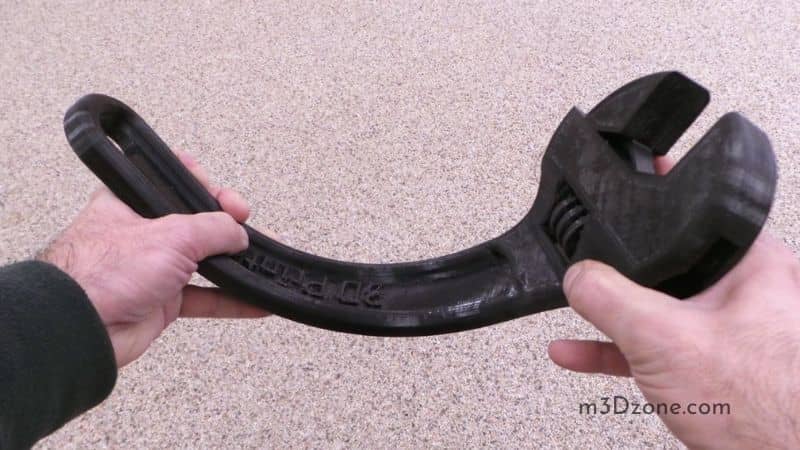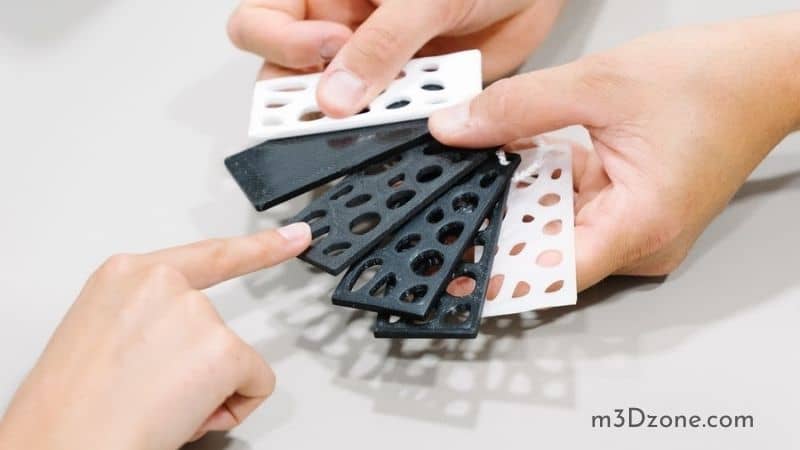Objects take shape as if by magic, created one layer at a time by a machine. They can be made of metals or even plastics. Digital printing plans are brought to life with less labor, material, and energy.

3D printing technology has the power to revolutionize the flow and scope of products to the market. The industry is expanding more rapidly due to the easy use of recyclable materials in closed-loop systems.
Quick Navigation
Is 3D Printing With Rubber Possible?
It is possible to create 3D print parts using rubber-like materials. 3D printing materials determine which optimal properties that allow engineers to simulate desiring high-end printers level.
Most rubber parts suit flexible production prototypes, for instance, soft handles that require shock absorption.
Thermoplastic elastomer makes rubber appealing, durable, and flexible at different levels. The qualities make it easier to achieve designs that will be impossible using other manufacturing technologies. The plastic imitates important properties of rubber to determine whether it is resistant to heat or abrasion.
Rubber materials are in high demand for industrial parts in the modern world. Lamination and casting require no design tool set up because of a soft rubber-like feel for easy molding.
The swiftness has made rubber 3D printing essential prototyping an excellent example of product development.
With rubber 3D printing materials, it is possible to achieve possible high print products with fewer flip flops than technologies.
From model walls and interior lattices having complex printing techniques, all of which might seem impossible to come up with a print quality but with the suitable materials, it opens up infinite ergonomic features.
Rubber-like 3D Printing Materials
Most of these rubber-like material questions depend on their print bed. Thermoplastic elastomers are a good example that can achieve flexibility and softness levels. They have heat resistance properties that are necessary for printing speed.
Other materials that achieve rubber-like materials include; silicone, thermoplastic polyurethane, and natural rubber or latex. Latex cannot undergo liquefaction and re-solidification to get the same print for the 3d print head.
Efficient gummy material is thermoplastic polyurethane(TPU); being one of the best two materials, thermoplastic elastomer(TPE) can be effective.
-
Thermoplastic Polyurethane(TPU)
TPU is valuable as it is flexible and robust. They are well known for higher abrasion, thermal and chemical resistance. Because of their unique mechanical and accessible conventional melting properties are used in footwear, sporting equipment, wheels, and cable holdings.
To get the best results while printing using TPUs, you must keep it dry. Dry the material for 46 hours at 70 degrees celsius and transfer it to a sealed container. Generally, softer TPUs print more slowly than harder ones.
Industrial applications of TPUs are made in putting parts that can get smashed and stretched in automotive parts like plugs, gaskets, and custom protective cases like drone parts. Whenever you need rigid and flexible materials, TPU is a great choice.
-
Thermoplastic Elastomers (TPE)
TPE provides typical advantages of plastic materials. The benefit of this TPE gives the printouts the ability to stretch to moderate elongations, and upon stress release, they return to their original shape. With that, it provides elements with a longer life cycle.
Fortunately, TPEs provide benefits of ease of manufacturing through processes like injection molding. The crucial property of TPEs is that they combine rubber-like and thermoplastic properties.
They are recyclable, require little compounding, and slight batch-to-batch variation, leading to better consistency final product.
Because of their thermoplastic properties, TPEs are very easy to process. The most common is injection molding and extrusion; they provide fast cycle times, which are economical.
Blow molding and thermoforming processes can be used as well. If you’re looking for footwear, medical, wire, and cable applications, thermoplastic elastomers are the best choice.
Rubber-like Filaments With Which You Can 3D Print
Initially, flexible filaments were too soft, and whenever printing was done, results were unexpected 3d printing products causing trouble for designers. A flexible filament can print thin layers at high print speed.
They are not toxic, but their downsides cannot withstand brute force even from a small distance. Even vibration force in the open air from the printer makes the flexible filaments not regain their original form.
Standard flexible filaments material is a thermoplastic elastomer (TPEs). Some of the 3d printing applications include sealing rings and shoe soles ware. TPU filament offers sporting equipment and gasket applications.
Rubber-like Resins That You Can 3D Print With
Flexible resins come in as they can produce rubber parts prints. Flexible resin can maintain its original 3d printing design even going through bendings and twisting.

When in need to make custom grips, stamps, or when adding a few tips of ergonomic features on your assemblies, then flexible resin is the best material choice.
Synthetic materials made of resin always bounce back to their final solid object state. The limit comes in as most resins design comes with specific printers.
a) Xyz Flexible Resin Nobel 1.0 3D Printer
The resin is flexible, making the organic material withstand brute bending forces at high speeds. The material prints are bendable, offering standing resilience.
b) Formlabs’ Flexible Resin
Its performance, when under stress and stretch, returns the resin to its original structure. Its compressible parts bend, and upon stress release, its 3d printing material state is maintained.
c) Druckwege Pro Flex Resin
DLP/UV light sources print this resin, improving its bending resistance. The flexibility property of the resin material accounts for its strength to maintain its original shape.
How Do You 3D Print Flexible Filament?
The question of how 3d print flexible filament is entirely dependent on your 3d printing printer. The filaments tend to have issues with moisture; dry them and know how to keep them dry.
Use a print dry to remove water from the liquid molecules layer of the filament. A dry filament reduces print adhesion as the polymer is dry.
By slowing down your printing settings, you decrease the pressure building up in the nozzle. There are no exact printing settings, as they vary as a result of their more advanced design. Get the first layer right as it is the direct-drive foundation upon which other layers are built.
You need an excellent basement material for 3d printing material to function properly.
3D Printing on blue painters. Make the tapes align perfectly without overlapping. Keep bed temperature too low when using blue tape. Replace the tapes after 5 to 10 prints. Direct drive 3d printing on a glass with a heated bed.
Recommend getting the right temperature until you get the 3D printing output you desire. Higher temperatures will lead to poor retraction settings. Lower temperatures will lead to insufficient fluid controllably.
Can 3D Printers Print Rubber? Can You 3D Print Rubber?
3D printing technology has slowly changed our lives. After years of innovating 3d printers, there is an open possibility to print rubber. It publishes high-performance 3d printing rubbers through silent circuit design, wiring harness, and new hotbed glass coating to make the 3d printing experience better.
A 2.85 filament design printer head guarantees the best accuracy shaping condition to print highly elastic rubber products. It offers additive manufacturing by building an object layer by layer.
It allows you to connect to other 3D printers when printing common materials. As a revolutionary product, 3D Printing brings more extraordinary imagination to create space for commercial value.
Conclusion
Companies can generally make money on expensive 3D Printing only if they can speed up production. They will use fewer materials, and some products can be recycled even if they are custom-made.
About 80 percent of printed products are made of plastic, and only a fraction of them are recyclable or biodegradable.
Plastic bottles picked up from garbage can be recycled into plastic filaments for 3D printing.
Those who collect the bottles can earn some more income. 3D Printing enhances local added value cycles all over the world, converting discarded plastics into valuable products.
Recommended Reading
Food Safe Coating and Sealants for 3D Prints
Food safe coating for 3D prints. What are they? A food-safe coating is critical for manufacturing 3D models ensuring that the food they handle remains safe.
3D Printing Shells. Useful Guide for Optimal Parameters!
When it comes to 3D printing, there are a lot of terms to learn. One is shell thickness. What exactly are 3D printing shells? How to set optimal parameters?
3D Printing Elephant Foot Issue. How Do You Fix It?
Let's dive into this 3D printing elephant foot issue. What is an elephant foot in 3D printing and how do you get rid of it? Why is it a common problem? Let's find out!
